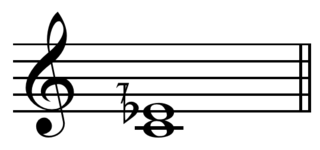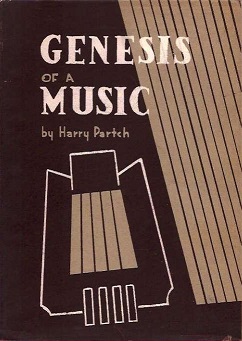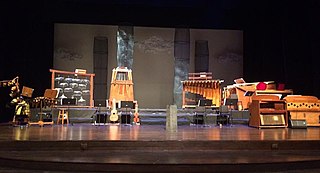
In music, just intonation or pure intonation is the tuning of musical intervals as whole number ratios of frequencies. An interval tuned in this way is said to be pure, and is called a just interval. Just intervals consist of tones from a single harmonic series of an implied fundamental. For example, in the diagram, if the notes G3 and C4 are tuned as members of the harmonic series of the lowest C, their frequencies will be 3 and 4 times the fundamental frequency. The interval ratio between C4 and G3 is therefore 4:3, a just fourth.

In music theory, limit or harmonic limit is a way of characterizing the harmony found in a piece or genre of music, or the harmonies that can be made using a particular scale. The term limit was introduced by Harry Partch, who used it to give an upper bound on the complexity of harmony; hence the name.

In Western classical music, a minor sixth is a musical interval encompassing six staff positions, and is one of two commonly occurring sixths. It is qualified as minor because it is the smaller of the two: the minor sixth spans eight semitones, the major sixth nine. For example, the interval from A to F is a minor sixth, as the note F lies eight semitones above A, and there are six staff positions from A to F. Diminished and augmented sixths span the same number of staff positions, but consist of a different number of semitones.
In Western music, the adjectives major and minor may describe an interval, chord, scale, or key. A composition, movement, section, or phrase may also be referred to by its key, including whether that key is major or minor.

Otonality and utonality are terms introduced by Harry Partch to describe chords whose pitch classes are the harmonics or subharmonics of a given fixed tone (identity), respectively. For example: 1/1, 2/1, 3/1,... or 1/1, 1/2, 1/3,....
An Otonality is that set of pitches generated by the numerical factors (...identities)...over a numerical constant in the denominator. Conversely, a Utonality is the inversion of an Otonality, a set of pitches with a numerical constant in the numerator over the numerical factors...in the denominator.

In music theory and tuning, a tonality diamond is a two-dimensional diagram of ratios in which one dimension is the Otonality and one the Utonality. Thus the n-limit tonality diamond is an arrangement in diamond-shape of the set of rational numbers r, , such that the odd part of both the numerator and the denominator of r, when reduced to lowest terms, is less than or equal to the fixed odd number n. Equivalently, the diamond may be considered as a set of pitch classes, where a pitch class is an equivalence class of pitches under octave equivalence. The tonality diamond is often regarded as comprising the set of consonances of the n-limit. Although originally invented by Max Friedrich Meyer, the tonality diamond is now most associated with Harry Partch.
12 equal temperament (12-ET) is the musical system that divides the octave into 12 parts, all of which are equally tempered on a logarithmic scale, with a ratio equal to the 12th root of 2. That resulting smallest interval, 1⁄12 the width of an octave, is called a semitone or half step.

Ervin Wilson was a Mexican/American music theorist.

In music, the septimal minor third, also called the subminor third or septimal subminor third, is the musical interval exactly or approximately equal to a 7/6 ratio of frequencies. In terms of cents, it is 267 cents, a quartertone of size 36/35 flatter than a just minor third of 6/5. In 24-tone equal temperament five quarter tones approximate the septimal minor third at 250 cents. A septimal minor third is almost exactly two-ninths of an octave, and thus all divisions of the octave into multiples of nine have an almost perfect match to this interval. The septimal major sixth, 12/7, is the inverse of this interval.

Music theory analyzes the pitch, timing, and structure of music. It uses mathematics to study elements of music such as tempo, chord progression, form, and meter. The attempt to structure and communicate new ways of composing and hearing music has led to musical applications of set theory, abstract algebra and number theory.

Genesis of a Music is a book first published in 1949 by microtonal composer Harry Partch (1901–1974).

The harmonic seventh interval, also known as the septimal minor seventh, or subminor seventh, is one with an exact 7:4 ratio (about 969 cents). This is somewhat narrower than and is, "particularly sweet", "sweeter in quality" than an "ordinary" just minor seventh, which has an intonation ratio of 9:5 (about 1018 cents).

In musical tuning systems, the hexany, invented by Erv Wilson, represents one of the simplest structures found in his combination product sets.
Dynamic tonality is a paradigm for tuning and timbre which generalizes the special relationship between just intonation, and the harmonic series to apply to a wider set of pseudo-just tunings and related pseudo-harmonic timbres.

In musical tuning, a lattice "is a way of modeling the tuning relationships of a just intonation system. It is an array of points in a periodic multidimensional pattern. Each point on the lattice corresponds to a ratio. The lattice can be two-, three-, or n-dimensional, with each dimension corresponding to a different prime-number partial [pitch class]." When listed in a spreadsheet a lattice may be referred to as a tuning table.

7-limit or septimal tunings and intervals are musical instrument tunings that have a limit of seven: the largest prime factor contained in the interval ratios between pitches is seven. Thus, for example, 50:49 is a 7-limit interval, but 14:11 is not.

The 833 cents scale is a musical tuning and scale proposed by Heinz Bohlen based on combination tones, an interval of 833.09 cents, and, coincidentally, the Fibonacci sequence. The golden ratio is , which as a musical interval is 833.09 cents. In the 833 cents scale this interval is taken as an alternative to the octave as the interval of repetition, however the golden ratio is not regarded as an equivalent interval. Other music theorists such as Walter O'Connell, in his 1993 "The Tonality of the Golden Section", and Loren Temes appear to have also created this scale prior to Bohlen's discovery of it.

The American composer Harry Partch (1901-1974) composed using scales of unequal intervals in just intonation, derived from the natural Harmonic series; these scales allowed for more tones of smaller intervals than in the standard Western tuning, which uses twelve equal intervals. The tonal system Partch used has 43 tones to the octave. To play this music he invented and built many new instruments, with names such as the Chromelodeon, the Quadrangularis Reversum, and the Zymo-Xyl.
In music, 58 equal temperament divides the octave into 58 equal parts of approximately 20.69 cents each. It is notable as the simplest equal division of the octave to faithfully represent the 17-limit, and the first that distinguishes between all the elements of the 11-limit tonality diamond. The next-smallest equal temperament to do both these things is 72 equal temperament.
















